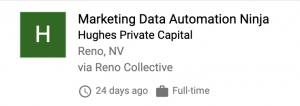
Learning how to write a job description is like mastering an art form.
It needs to accomplish a number of things in a very short time. It needs to explain the job itself, portray your employer brand, attract certain candidates, include Google ranking signals, and grab people’s attention.
That’s a big ask! But it is doable… as long as you avoid a few key mistakes.
Let’s look at 7 mistakes to avoid in your job descriptions to help you craft the perfect job ad.
It’s tempting to try to make jobs sound more exciting in order to grab people’s attention. We’re sure you’ve seen jobs like ‘Data Ninja’, ‘Growth Hacker,’ and ‘Office Guru’ making the rounds on job boards and career websites.


While these might lead to more clicks on the job ads, the titles themselves are meaningless. The clicks they would provide would likely be to understand what the title even means, not necessarily leading to more applications.
Not only that, but these types of titles can also deter candidates from applying. They’re confusing and most people don’t understand what they actually mean, which often leads to fewer applicants.
Using gendered pronouns and language in your job description can unintentionally alienate certain populations.
If your posting is filled with masculine pronouns (‘He should have a degree’, ‘his experience should include’) & language (brother, salesman, fireman, etc), it makes it difficult for those of other genders to visualize themselves in the position. It also reflects poorly upon you as an employer to use solely gender-biased language.
This can be true with other types of gendered language, like certain adjectives & connotations. For example, emphasizing a “competitive spirit” or “natural born leadership abilities” is often linked to masculine biased qualities, also alienating other populations.
Keep language neutral with gender-neutral pronouns like they/them and avoid other gendered language. Get a few fresh eyes on the job description from those of different genders and backgrounds before posting it to get the thoughts of others.
Striking the perfect middle balance between providing enough information without providing too much is key to crafting a great job description. Of course, this is easier said than done.
A good range for job descriptions is between 300 and 700 words. This gives you enough space to accurately describe the position, the company, and any position requirements.
Did you know that saying or even just reading negative words affects our brains? Studies show that even
“a single negative word can increase the activity in […] the fear center of the brain [which] releases dozens of stress-producing hormones and neurotransmitters.”
The last thing you want is for a potential candidate to read your job description and associate with negativity, stress, and anxiety.
You might even think that there aren’t negative words in the posting, but it can be surprising what words are considered negative. Some common examples we see are:
Candidates want to see exactly what they are applying to – they don’t want to guess. Just as you should avoid confusing & vague job titles, you should also avoid being too vague in the job description.
While vague and exciting (albeit confusing) job descriptions and titles could get you more applications, this also means you’ll likely be getting applicants who aren’t qualified for the position. And this wouldn’t be the fault of the applicants — the fault would lie with the unclear or undefined job description.
Include all relevant information about the job, requirements, and qualifications necessary. This will help target the right applicants, making the process efficient for both employer and job seeker alike.
You might think jargon might work to target your ideal candidate, but jargon can often alienate readers instead. Using regular & simple words makes the job description & posting more accessible to a wider variety of job seekers.
Remember, a lot of jargon isn’t necessarily industry-wide and can often go out of style with new developments and eras. Using simpler & more widely understood words makes the job seem more attainable and attractive to most applicants.
Getting too specific or demanding with your expectations is another surefire way to alienate candidates and to make the search harder for yourself.
A common joke making the rounds on LinkedIn is some companies requiring 15 years experience with a software that’s only been around for 10. Or 2-3 years experience for an entry level job.
Be fair to the candidates. Eventually one of them will be a part of your team.
Job description mistakes can make the candidate search long, grueling, and, oftentimes, unsuccessful.
Learning how to write a job description can take a long time of trial and error, but reading this article is a great place to start. Expand your knowledge by reading our tips on how to write a great description with job description examples and tips on our blog.
The help doesn’t stop there, either. Jobiak’s recruitment technology makes it easier than ever to optimize and structure your job listings to post on Google for Jobs.
Learn more about how our technology makes recruiting efficient and fast on our site here, and don’t hesitate to contact us for more information!